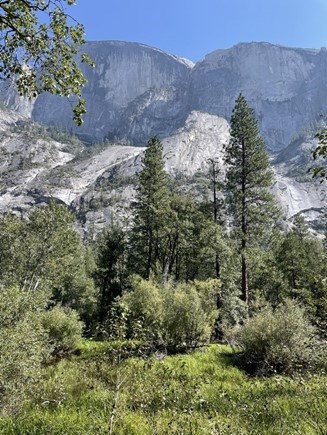Last updated: November 15, 2023
Article
Yosemite FaceLift 2023

Yosemite Archeology Office
Introduction
During September 2023, I assisted the Yosemite National Park (YOSE) volunteer staff with their annual Facelift event. In 2003, the Yosemite Climbing Association created the Facelift event. It is a 5-day volunteer trash pick-up event. Now, Facelift is Yosemite’s official NPS Public Lands Day Event! The special project I worked on was the creation of educational materials for the Archeology Office. This project was near to my heart because I studied Sociology and Anthology in college and took archeology classes. I created posters for the event’s archeology booth that educated the public about historical trash and assisted their team with archaeology talks during the event.
Special Projects
At the first Facelift, NPS did not participate. In 2006, the Yosemite Archeology Office discovered that Facelift volunteers were inadvertently collecting historic-era artifacts mistaking them for trash. Today, NPS archeologists have been formally involved in planning and mobilizing for the annual Facelift event. The event’s special projects are reviewed by the Yosemite Archeology Office. To avoid inadvertent artifact collection, large artifact surface collection sites have been identified throughout the park and blocked off for trash pick-up on the official Facelift map.

Yosemite Archeology Office
Trash or Treasure
All the trash that is collected is sorted through by the archeology volunteers. If artifacts are identified, the collector is interviewed to determine the exact location the artifact was collected. Volunteers are provided with a pocket identification guide. If people are unsure, they can bring photographs to the archeology table and park staff will help to identify the items. Each volunteer who registers for the event is required to participate in Yosemite archeology training! In the 2- minute briefing, they learn about why archeology is important, how to identify artifacts, and how it is illegal to remove artifacts from a National Park.
Education & Archeology Talks
I had the opportunity to work with the public and local schools during this event. I felt like I was a part of the community, and it was one of the most impactful aspects of my fellowship experience so far. During the archeology talks, I educated visitors about leave no trace behind, cultural archaeology, and historical trash in YOSE. I used the educational posters I created as well as examples of historical trash that had been collected in previous years during the facelift events. The younger students asked questions about the federal law that prohibits collection of any artifacts that are 50 years or older. The participants enjoyed the vintage soda cans and bottles and wanted to learn more about how to identify them in the field.

Abigail Stone Lauer
Conclusion
Most of my fellowship has been remote, and I have missed working with visitors in-person, so I enjoyed working with park staff, visitors, and tourists from all over the world. Living in Southern California, I don’t often get to see trees and rock formations like the ones I got to see in the park. I was reminded of how important it is to get out into nature and make sure to keep trails clean. I developed skills and learned how to coordinate and event plan for a large-scale multiple day public land day for the National Parks. Being able to work in Yosemite National Park has been a highlight of my fellowship so far.
Visit the Yosemite Climbing Association website and find FaceLift event near you!
Written by Abigail Stone Lauer
for "A Day in the Life of a Fellow" Article Series
National Park Service - Workforce Management Fellow
